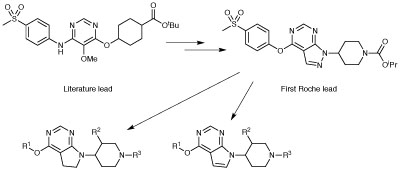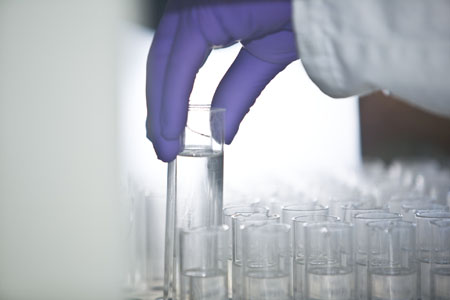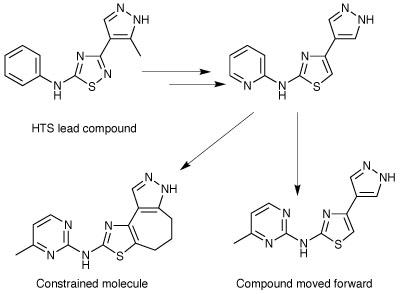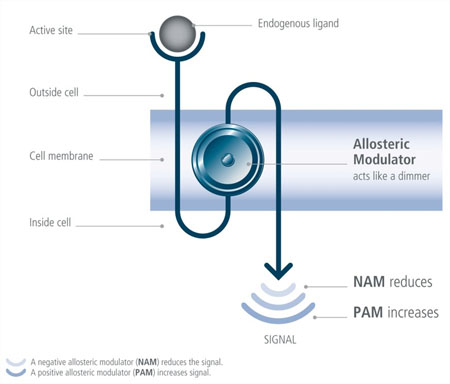Medicinal chemists are having to come up with ingenious ways to improve the potency, efficacy, solubility and metabolism of new drug candidates. Dr Sarah Houlton describes some of the processes being adopted.
New drugs rarely just ‘happen’ – they are invariably the result of painstaking work by medicinal chemists. They take an initial lead compound and improve its potency, efficacy, and properties such as solubility and metabolism, to create a molecule that works well while having as few side-effects as possible. This process involves a lot of systematic design work, and the molecules then have to be synthesised so they can be tested.
Several drug discovery stories were shared at the Advances in Synthetic and Medicinal Chemistry conference, held in St Petersburg, Russia in August. For example, Pfizer’s Mark Flanagan gave an account of the discovery of tofacitinib, the company’s JAK inhibitor that is in late stage trials for rheumatoid arthritis and several other conditions (Figure 1). There are four JAK signalling kinases – JAK-1, JAK-2, JAK-3 and Tyk-2, and they always work as dimers, 1 with 3 and 2 with Tyk-2. The team’s idea was to focus on JAK-3, which is involved in T and B cell activation and proliferation, because of the potential in rheumatoid arthritis, as well as blood cancers.
Their initial lead came from a 400,000 compound library screen. Although this molecule had some activity, many of its attributes needed improvement. It had 210nm activity, but they wanted it to be below 10nm; they also wanted the selectivity over JAK-2 to be greater than 100-fold, while the lead’s selectivity was 45-fold. Several other parameters also needed significant improvement.
Initial structure–activity relationship analysis indicated that hydrogen groups gave better activity than any other substituents on the pyrrolopyridine group, so they initially focused on the amino head group, which bore a tricyclic secondary amine in the hit compound. To start with, they looked at cyclohexyl groups, and found that having a methyl group at the 2’ position was very important for improving potency, and 2’,5’- substitution looked best in the screen. Even as a mix of isomers, it was eight times more potent than the bare cyclohexyl substituent.
To reduce the number of stereoisomers, they looked at the cheap, chiral natural product S-carvone, which gave an amine adduct that was a mixture of two diastereomers, not the four that were formed using the achiral starting material. These could be separated. The next step was to change the double bond of the carvone unit, but at that time there were no X-ray structures of JAK, so the ‘pocket’ on the target had to be explored experimentally. They looked at a piperidine scaffold, which reduced the lipophilicity compared with the cyclohexyl group, with the added advantage of making it easier to generate analogues through a more convergent synthesis. Ultimately, the best results were seen with the cyano derivative, and this went forward to development and became tofacitinib. It is small, polar and potent, with both good solubility and good bioavailability.
The researchers were a little concerned that the selectivity over JAK-2 might not be good enough, but in fact this turned out not to be a problem. The four JAK enzymes are fairly similar to each other, Flanagan said, and when they looked at it more closely this compound is actually a dual JAK-1 and JAK-3 inhibitor, with about 25-fold selectivity over JAK-2. Tofacitinib is currently in Phase III trials for rheumatoid arthritis, and the submission for approval is being prepared. It is also in Phase III as an oral treatment for psoriasis, with a topical version also being investigated, plus Phase II for several other conditions.
An account of Roche’s discovery programme for GPR119 agonists to treat Type II diabetes was given by Sherrie Pietranico-Cole from the company’s Nutley, NJ, US site. Activating this receptor is a novel strategy for glucose control (Figure 2). It is a GPCR whose distribution in humans is restricted to the pancreas and the gastrointestinal tract. When activated, it directly promotes glucose-dependent insulin secretion from beta-cells in the pancreas via cAMP elevation; this elevation also promotes beta-cell health. Meanwhile, in the intestines, activating GPR119 also stimulates the secretion of glucagon-like peptide-1, further enhancing insulin secretion and glucose control. Drugs that mimic the activity of GLP-1 are already available and lower both glucose and body weight in humans, while preserving beta-cells. This implied that the GPR119 activation strategy could succeed.

Figure 2: A novel strategy for glucose control
This time, the starting point was a literature lead, published by Arena. They outsourced the synthesis of multiple compound libraries, which were ranked by three-dimensional and electrostatic similarity to the literature lead. They identified a pyrazolopyrimidine lead compound where the patent literature was clear, and while its agonist activity was not too bad, it hit hERG and also had poor solubility. Both of these issues needed to be resolved.
To eliminate the hERG activity, the research team looked to replace the pyrazolopyrimidine core as fewer hydrogen bond acceptors could be advantageous, and also tried replacing the left hand and right hand sides of the molecule. Switching the sulfur-bearing benzene ring for a benzoic acid or a pyridine did indeed reduce hERG, but these also killed the activity. Similarly, switching out the aromatic core did not work – indeed, this increased hERG and also led to a loss of all activity. Altering the right hand side was much more effective, with both piperidyl and cyclohexyl analogues retaining activity while reducing hERG potential.
The next task was to increase potency and improve clearance. For the latter, they studied metabolites, and while all gave better clearance, they also gave glutathione addition, which rendered them a no-go because of the potential for side-effects. Taking one nitrogen out of the core, either with or without reducing one double bond, or switching the oxygen linker for a nitrogen, removed the propensity for glutathione addition, although the potency plummeted in the latter. This still gave two promising new series – pyrrolopyrimidine and its dihydro analogue – both of which were pursued.
In each case, the in vitro safety was acceptable, as were the pharmacokinetics in rats, and both were tested in GLP-1 secreting cells. In the presence of glucose, they stimulated the release of GLP-1. In the absence of glucose, no GLP-1 was released. Both gave a significant reduction of glucose in a diabetic rat model – between 30 and 39% – but potency still needed to be increased so the dose could be reduced.
Further study of metabolites led to an analogue where the right hand carbamate was replaced, and not only was this a little more potent, there was no hERG activity and all the other parameters were acceptable. A range of other modifications were tried to increase the potency further, with a trifluoromethyl substituted pyrimidine proving even better. Putting all the modifications together left them with two series that had no glutathione addition, and gave good GLP-1 secretion in the model.

Research in the chemistry laboratory at Roche, Basel
Photo courtesy of Roche
positive allosteric modulation
Sylvain Celanire of Addex Pharmaceuticals spoke about the company’s work on allosteric modulators in treating Parkinson’s disease, which is being carried out in partnership with Merck (Figure 3). Unlike traditional agonist and antagonist drugs, which compete for the same receptor site as the endogenous ligands, allosteric modulators bind via a non-competitive mechanism, usually on the cell surface. This has an effect on signal transduction, usually after the endogenous ligand has bound to the active site, and can be either positive or negative.

Figure 3: Allosteric modulators used in treating Parkinsons disease
Two allosteric modulator drugs are already available for very different conditions – Pfizer’s AIDS drug maraviroc (Selzentry/Celsentri), which acts at the CCR5 cell surface receptor to prevent viral entry, and Amgen’s cinacalcet (Sensipar/Mimpara), which mimics the calcium-sensing receptor and is used to treat secondary hyperparathyroidism in end-stage kidney disease. Many others have reached Phase II trials.
Addex is investigating the positive allosteric modulation of the metabotropic glutamate receptor 4, or mGluR4, as a potential way to treat Parkinson’s. The rationale behind this as a target for the disease is that it is highly expressed at the striatopallidal synapses in the basal ganglia circuits, which are a key area for motor control and movement. Activating mGluR4 may restore the balance between the direct and indirect neuronal pathways by decreasing GABA and glutamate neurotransmitter tone. There is evidence of efficacy in in vivo Parkinson’s models, and there is also evidence in mouse models that positive allosteric modulation may prevent dopaminergic neuron degeneration.
Both agonists and positive allosteric modulators have already been studied by a number of companies, but selectivities were poor, and there was low brain penetration. Addex ran a high throughput screen on its library of about 70,000 compounds, and identified several distinct and unique chemotypes, with good tractability. The primary hit, a heteroaryl pyrazole-based compound, had positive allosteric modulation activity in the low micromolar range. For a successful drug, Celanire said, they needed to reach nanomolar potency and full efficacy at mGluR4, with greater than 100-fold selectivity against other mGluR subtypes. It also needed better ADME parameters.
Several areas of the molecule were investigated in a medicinal chemistry programme. The left hand side phenyl group was replaced by heteroaryl rings, and the substitution pattern varied. Alternative central cores and substitution patterns were looked at, as were introducing conformational constraint on the right hand biaryl system by cyclisation, and modification of the pyrazole group on the right. Potency was increased by introducing a pyridyl group on the left hand side, as it did when the central core was replaced with a thiazole, and also when the methyl group on the pyrazole was removed. Swapping the pyridine for a pyrazine also aided potency and efficacy, but metabolic turnover was too high.
The next step was to investigate conformational constraint, and introducing a seven-membered ring link on the right hand side looked promising, with the metabolic profile improving, and potency and efficacy were retained. However, overall the non-fused compound had a superior overall pharmaco-logical profile, and this was selected for further investigation in proof of concept studies. In rats, it reversed induced forelimb akinesia in combination with L-dopa, without increasing L-dopa-induced dyskinesias. It also reverses haloperidol-induced catalepsy in rats.
Antibody-linked cytotoxic drugs are not a new idea – the concept of using an antibody joined to a toxic agent by a linking group to target a tumour is at least 25 years old, and they are, essentially, very complex prodrugs. However, according to John Flygare of Genentech, the problem has been the narrow therapeutic window between maximum tolerated dose and minimum efficacious dose.
antibody–drug conjugates
There are many different variables that can be considered when designing an antibody–drug conjugate. The antibody itself might be a full length antibody or a fragment of an antibody, there are many different antigens that might be targeted, and the way the linker releases the drug can be altered – for example, it might be pH or redox sensitive, or even cleavable by an intracellular protease enzyme.
Then there is a whole range of cytotoxic drugs that might be used, the number of drug molecules attached to each antibody can be varied, as can the chemistry used to link them together, for example, via a lysine or cysteine residue, and the part of the antibody to which they are attached.
There is a balance to be struck regarding how readily the drug is released from the antibody. Ideally, it should be released inside the cell, but equally it should not be released prematurely in the blood and cause toxic effects, or be so stable that it is difficult to separate from the antibody once it reaches the active site.
One such drug has already reached the market – Mylotarg (gemtuzumab ozogamacin) from Wyeth (now Pfizer) for acute myeloid leukaemia, where the cytotoxic drug was calicheamicin, but this was withdrawn a couple of years ago because the risks were ultimately shown not to outweigh the benefits.
Very recently, a second was approved – Seattle Genetics’ SGN-35 for Hodgkin lymphoma and acute lymphocytic leukaemia – and at least 10 more antibody–drug conjugates are in various stages of clinical trials for a number of different cancers. One of these developmental drugs, trastuzumab-DM1, is in Phase II/III trials at Genentech for Her-2 positive breast cancer. Neither the antibody itself – better known as Herceptin – nor DM1 give much anticancer activity on their own, but when they are combined, a durable response is seen. It is far more potent than trastuzumab alone, Flygare said.
In a Phase II trial comparing the conjugate with the antibody alone plus docetaxel in HER2-positive breast cancer that was either locally advanced or metastatic, while there was not a huge amount of difference in the activity between the two groups, the big differentiator was safety – there were twice as many serious adverse events in the patients given standard of care treatment. The conjugate is now in Phase III trials.
The company is now working on second generation conjugates, designed to control non-specific uptake of the conjugates, new linkers, and drug molecules with different mechanisms of action. For example, it has found that selective and specific conjugation can be accomplished with a genetically engineered antibody containing cysteine residues that gives more homogeneous conjugates with several drug molecules in each. These give the same effect at the same mg/kg dose, but for a matching number of active molecules within the conjugate they give a more durable response.

Addex Pharmaceuticals is developing an emerging class of small molecule drugs, called allosteric modulators. These orally available therapeutic agents offer greater selectivity and better modulatory control at disease mediating receptors compared with traditional therapies. Most current drugs bind receptors where the natural molecular activators of the body bind, specifically to the active site. In short, most drugs must out-compete endogenous ligands to bind to the active site. Allosteric modulators are non-competitive because they bind receptors at a different site and modify receptor function even if the endogenous ligand also is binding. This means they are not limited to simply turning a receptor on or off. Instead, they act more like a dimmer switch, offering control over the intensity of activation or deactivation, while allowing the body to retain control over initiating receptor activation.
Pictures courtesy of Addex




